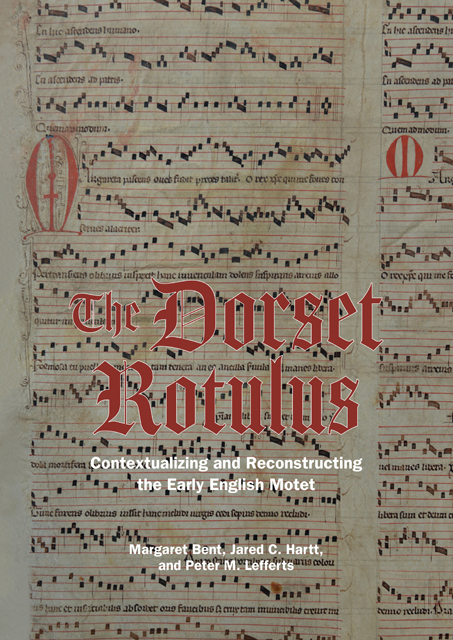Book contents
- Frontmatter
- Contents
- List of Figures
- List of Music Examples
- List of Tables
- Abbreviations
- Note on the Transcriptions
- Introduction
- 1 The Source and its Contents
- 2 Contexts and Designs
- 3 Voice-Exchange Motets and Ascendenti sonet geminacio/ Viri Galilei
- 4 Margareta pascens oves and its Large-Scale Comparands
- 5 Rota versatilis: Towards a Reconstruction
- 6 The Curious Case of Regina preminencie/ Gemma nitens/ … mater es intacta
- 7 Introducing Naufragantes visita/ Navigatrix inclita/ T. Aptatur/ … velox perpetrat
- 8 The Musical Rotulus: Artifact, Image, and Attributes
- 9 Epilogue: Conclusions and Speculation
- Appendix: Transcriptions, Texts, and Translations of the Four Dorset Motets
- Bibliography
- Index of Manuscripts
- Index of Musical Compositions
- General Index
- Studies in Medieval and Renaissance Music
8 - The Musical Rotulus: Artifact, Image, and Attributes
Published online by Cambridge University Press: 14 January 2023
- Frontmatter
- Contents
- List of Figures
- List of Music Examples
- List of Tables
- Abbreviations
- Note on the Transcriptions
- Introduction
- 1 The Source and its Contents
- 2 Contexts and Designs
- 3 Voice-Exchange Motets and Ascendenti sonet geminacio/ Viri Galilei
- 4 Margareta pascens oves and its Large-Scale Comparands
- 5 Rota versatilis: Towards a Reconstruction
- 6 The Curious Case of Regina preminencie/ Gemma nitens/ … mater es intacta
- 7 Introducing Naufragantes visita/ Navigatrix inclita/ T. Aptatur/ … velox perpetrat
- 8 The Musical Rotulus: Artifact, Image, and Attributes
- 9 Epilogue: Conclusions and Speculation
- Appendix: Transcriptions, Texts, and Translations of the Four Dorset Motets
- Bibliography
- Index of Manuscripts
- Index of Musical Compositions
- General Index
- Studies in Medieval and Renaissance Music
Summary
The most outstanding physical feature of the Dorset music fragments is that they were once part of a rotulus. This chapter takes that observation as its starting point. It seeks to place the Dorset rotulus within the context of surviving medieval rolls with musical notation from the 1250s to around 1600 by correlating the evidence of manuscripts, images, and textual references. The current list of these manuscript rolls, international and multipurpose, stands at sixty-six items. English rolls, and rolls of motets, will be distinguished below.
Most categories of later medieval scroll are now under firm bibliographic control, and those of a given type (for example, administrative and judicial rolls, prayer rolls, genealogical rolls, heptarchy rolls, mortuary rolls, alchemical rolls, etc.) can be examined for conformity to generic norms. As we will see, however, the sixty-six musical scrolls in our list are not all of one kind. Rather, they fill a number of different textual and functional needs. What follows here is a proposal for a way to sort them out that yields a subset – including our manuscript – that is indeed one distinctive type cultivated for a limited period of time c. 1250–1375. This is the rotulus motetorum, a neologism offered here as a parallel to the late-medieval expression liber motetorum.
First, though, a few basics. The broadest operative generalization has it that over the course of the long Middle Ages, the ancient roll (rotulus, scroll) was largely replaced by the modern book (codex, liber, volumen). But surviving artifacts, images, and textual references demonstrate that the roll was never abandoned as a manuscript medium. Indeed, rolls were one of the two most common media for written texts in the later Middle Ages, the other being the codex, in the overall movement ‘from memory to written record’ in Western Europe in the 1100s and 1200s. From then into the 1500s, at a minimum, tens of thousands of later medieval rolls, especially administrative and judicial rolls, were inscribed, and thousands of them survive to the present day in public and private libraries, archives, and museums across Western Europe. Practically speaking, rolls – mundane and omnipresent – were the most familiar technology for writing down texts that would have been encountered on a daily basis by literate individuals.
- Type
- Chapter
- Information
- The Dorset RotulusContextualizing and Reconstructing the Early English Motet, pp. 299 - 334Publisher: Boydell & BrewerPrint publication year: 2021



